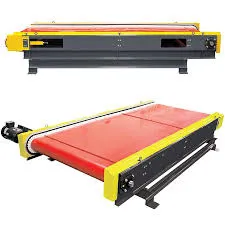

नवम्बर . 08, 2024 11:44 Back to list
Understanding the Eddy Current Separator How It Works
The growing need for recycling and efficient waste management has led to the development of advanced technologies for material separation. One of the most effective tools in this regard is the eddy current separator. This innovative device is widely used in the recycling and waste management industries, helping to separate non-ferrous metals from other materials. Understanding how an eddy current separator works is crucial for appreciating its role in creating a sustainable environment.
Principles of Eddy Currents
Eddy current separators operate on the principle of electromagnetic induction, which was first discovered by the scientist Michael Faraday. When a conductor moves through a magnetic field, or when there is a change in the magnetic field around the conductor, electric currents are induced within the material. These induced currents are known as eddy currents.
In the context of an eddy current separator, the device typically consists of a conveyor belt running over a rotating magnetic drum. The magnetic drum contains powerful magnets that create a magnetic field. As non-ferrous metals such as aluminum, copper, and brass pass over the conveyor belt and into the magnetic field, they produce eddy currents. These currents generate their own magnetic fields that counteract the original field, causing the non-ferrous metals to be expelled away from the other materials.
Components of an Eddy Current Separator
An eddy current separator consists of several key components that work together to achieve effective separation
1. Conveyor Belt The conveyor belt carries the mixed material toward the separator. It ensures a steady flow and distributes the material evenly across the separation area.
2. Rotating Magnetic Drum The core of the separation process is the rotating magnetic drum, which is positioned just above the conveyor belt. The speed and strength of the magnetic field can be adjusted to optimize the separation process.
3. Separator Housing The housing holds both the conveyor belt and the magnetic drum, ensuring that materials are directed correctly and that the magnetic field is contained effectively.
5. Drive System This system powers the conveyor belt and the rotating drum, providing the necessary movement for the separation process to occur.

The Separation Process
The process begins when mixed material, such as shredded waste or recycling materials, is loaded onto the conveyor belt. As the material travels along the belt, it approaches the rotating magnetic drum. The strong magnetic field interacts with the conductive non-ferrous metals, inducing eddy currents within them.
As the non-ferrous metals are influenced by the induced eddy currents, they are repelled from the conveyor belt and ejected to the side, often into a separate collection bin. Meanwhile, non-metallic materials, ferrous metals, and other components that do not react to the eddy currents continue down the conveyor belt and are discharged separately.
This method is not only efficient but also highly selective, enabling recyclers to achieve high recovery rates of valuable metals that would otherwise end up in landfills.
Benefits of Eddy Current Separators
Eddy current separators offer several advantages
- Efficiency They operate continuously and can handle large volumes of materials, making them suitable for industrial applications. - Selective Separation The technology can effectively distinguish between non-ferrous metals and other materials, ensuring minimal contamination.
- Cost-Effective By recovering valuable materials, they can significantly reduce waste disposal costs and contribute to more effective recycling processes.
- Low Maintenance The lack of moving parts in the separation mechanism means that maintenance requirements are relatively low, allowing for reduced downtime.
Conclusion
Eddy current separators are a vital technology in the recycling and waste management industries. They rely on fundamental principles of electromagnetism to effectively separate non-ferrous metals from other materials. By understanding how an eddy current separator works, we can appreciate its significance in promoting sustainable practices and resource recovery. As the world continues to seek more efficient methods for handling waste, eddy current separators will undoubtedly play a crucial role in advancing recycling technologies.
Latest news
Troubleshooting Common Eddy Separator Problems
NewsJul.04,2025
The Role of Metal Recycling Plants in Circular Economy
NewsJul.04,2025
The Impact of Recycling Line Pickers on Waste Management Costs
NewsJul.04,2025
Safety Features Every Metal Shredder Should Have
NewsJul.04,2025
How Industrial Shredders Improve Waste Management Systems
NewsJul.04,2025
How Cable Granulators Contribute to Sustainable Recycling
NewsJul.04,2025